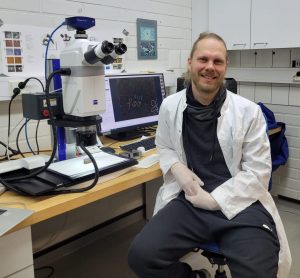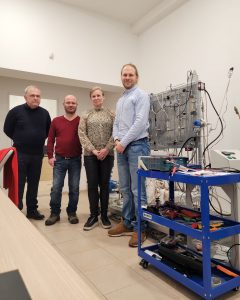
Senior Scientist
VTT
We started our visit by landing in the capital city, Sofia. The weather was surprisingly similar to the typical Finnish November weather, dark and wet. The surprise was even greater as we woke up the following morning, and the city was covered with snow!
Our kind hosts, professor Martin Bojinov and professor Iva Betova, picked us up from the hotel, and we drove roughly one kilometre to the campus of the University of Chemical Technology and Metallurgy of Sofia. Many of the campus buildings were originally constructed to be military barracks just after the Second World War but were briefly after that transferred for university use. We enter the faculty building with a wide hallway. Our meeting room is an old laboratory space turned into a small lecture room, although the room height made it expansive. Here we met associate professor Vasili Karastajev with warm welcomes.
We started our meeting by introducing our organisations. UCTM is the third biggest university in Bulgaria, with roughly 2000 students. There are three faculties with more than 20 departments, out of which Professor Bojinov is the head of the department of physical chemistry. Their research team comprises at the moment of five people and their focus areas are corrosion, electrochemistry and multiscale modelling of electrochemical processes. Just like VTT, UCTM has performed research on nuclear power chemistry and materials as well as renewable technologies.
I started presenting the VTT project portfolio on my behalf. The projects were jointly funded and public. Research topics related to hydrazine replacement studies in pressurised water reactor (PWR) secondary side coolant, magnetite deposition, turbidity measurements, heat storage material corrosion and stress corrosion cracking of 3D-printed 316L stainless steel material in PWR and BWR conditions were presented.
Professor Bojinov provided an outlook for a study comparing the effects of PWR primary side pH-adjusting chemicals LiOH and KOH on the corrosion of stainless steel 316L and nickel-based alloy A690. It seems that the two pH adjusting chemicals treat the stainless steel in a similar manner when it comes to the corrosion and oxide growth. In the case of A690, only small differences between the chemistries were observed. This topic is relevant if the Western-designed PWRs want to replace the use of LiOH with KOH.
Chief assistant professor Nikoleta Ivanova presented the use of molecular dynamics simulations in simulating adsorption processes on a magnetite surface. The work contained generating a representative magnetite unit cell structure and simulating the adsorption of ammonia molecules on the magnetite surface. The adsorption is depend on the temperature and a tentative correlation to experimentally determined interfacial parameters was suggested. The work helps further to understand the mechanisms behind the corrosion and magnetite deposition occurring in steam generators.
Associate professor Vasili Karastajev presented work related to developing a deterministic flow-assisted corrosion (FAC) model. Similar to the molecular dynamics simulations, understanding FAC helps mitigate the magnetite deposition occurring in steam generators. A specially designed test method for FAC was constructed and the FAC behaviour of low-alloyed steels was studied as a function of temperature and flow rate. According to the electrochemical impedance measurements, it was shown that the flow rate had only a weak effect on the FAC behaviour. Regarding the temperature, it was shown that the iron release rates peaked at 180 °C.
Laboratory visits included the introductions of the newly acquired scanning electron microscope (SEM), Raman spectrometer and GDOES. Furthermore, one high-temperature and pressure autoclave setup and electrolyser. Collaboration related to the use of Raman spectrometer was discussed, whether it could be applied in identifying molecules contained in commercial oxygen scavengers. GDOES, on the other hand, can provide information on the elemental composition of oxide films.

Vasili Karastajev, Elina Huttunen-Saarivirta and Konsta Sipilä
Research professor Elina Huttunen-Saarivirta presented the MASCOT project results regarding the corrosion in ammonia-containing environments, effect of ammonia on lubricants and erosion corrosion and pitting corrosion studies in low pH and halide-containing solutions. It was noticed that the GDOES analyses can provide insights into the oxide characterisation and this seems to be a feasible area where our organisations can collaborate in the MASCOT framework. In addition to the MASCOT project, the VTT hydrogen studies were presented. The topics were related to materials used in the hydrogen industry and hydrogen storage.
The atmosphere during the two-day visit was warm and the hospitality of the hosts was highly appreciated. Based on the presentations, it was obvious to both parties that there are common interests regarding currently running material studies. The support of providing GDOES analysis to the MASCOT project was considered to be valuable and performing additional were agreed. The results will be included in a scientific article to be prepared at the end of the MASCOT project. A longer-term and fruitful collaboration covering other projects besides the MASCOT is anticipated.
Besides the science discussion and new collaboration plans, it was nice to have a quick peek into the Bulgarian culture. The outlook of the city centre of Sofia is a mixture of old and new building styles, and the narrow streets hint that the city is indeed old and has a rich history. We even had a chance to try the local food, which was tasty, and especially the eggplant paste (kyopolou) was pleasant experience for the Finnish taste buds. All in all, the visit was a success, and both parties are looking forward to future collaboration
